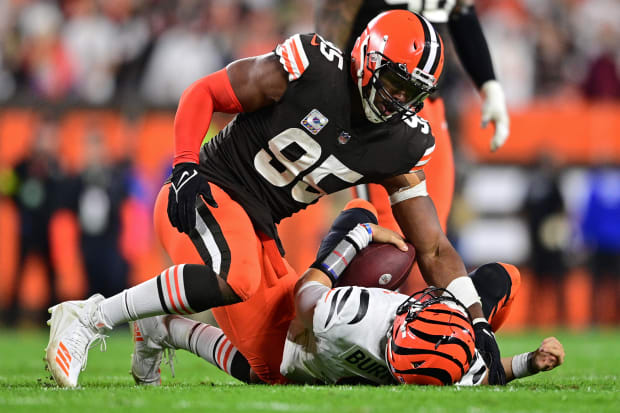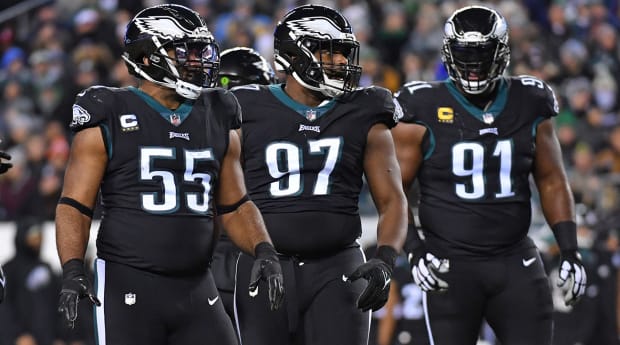Last year, two representatives from the league’s Madden generation of general managers completely upended the NFL’s free-agency period. Tyreek Hill, A.J. Brown and Davante Adams changing teams had a massive ripple effect on the NFL and course-corrected our view of what it means to build a stable contender, and whether it’s even worth exploring that possibility anymore.
In 2023, we have a new class of free agents, whom you can read about here. Here are a few predictions about where they will land, with a specific focus on various submarkets and a few different teams that will either spend lavishly … or not at all.

David Dermer/USA TODAY Sports
1. The Browns could be kicking the doors in on the defensive tackle market
I could see Cleveland—desperately needing a way to free up Myles Garrett in one-on-one situations—being one of the most aggressive teams in free agency this year on the defensive side of the ball. The Browns do not currently possess any defensive firepower in their front seven that can consistently peel Garrett away from being double- or triple-teamed. Last year, Garrett was the most double-teamed defensive player in the NFL. My understanding is that they view interior pressure as the avenue to alleviating that stress on Garrett. This means going after the likes of David Onyemata and Sheldon Rankins, both of whom could command larger price tags than expected this offseason, given the relative age and thinness of the defensive tackle market and the increased demand at the position.
2. The Chargers will be quiet
A year after spending $80 million in guaranteed cash just on new additions, the Chargers roll into the 2023 season at a bit of a crossroads. This year will represent the organization’s path moving forward, whether it be a vision more heavily crafted by general manager Tom Telesco or one shaped by the energetic Brandon Staley. Regardless, it seems like they will do so without the additions of many—if any—brand-name free agents. While this is not totally surprising given the Chargers have almost no salary cap space, they are preparing to hand over a monstrous contract to Justin Herbert at some point, and likely feel that the work they did last year should be enough to get them into playoff contention again in ’23.
3. Javon Hargrave will be the centerpiece of Arizona’s free-agency strategy
The Eagles’ defensive tackle is set to cash in this offseason. The 30-year-old projects for between $18 and $22 million on the open market, and the Cardinals are one team I could imagine championing his cause. While defensive line is not necessarily its weakest position—Arizona has plenty of holes—it’s hard not to imagine Hargrave being in love with new coach Jonathan Gannon’s scheme. Hargrave had career years under Gannon, making his first Pro Bowl in 2021 and logging a career high in sacks last year when Gannon was the Eagles’ defensive coordinator.
4. The Eagles will be the team to watch (again)
As an addendum to our defensive tackle market prediction above, the Eagles are poised to see almost the entirety of their defensive line hit free agency. Brandon Graham is reportedly drawing interest elsewhere, and is beloved enough in Philadelphia that I could see him being groomed for some type of role with the team if he decides, at age 35, that his playing days are through. C.J. Gardner-Johnson, James Bradberry, Isaac Seumalo, Jason Kelce, Miles Sanders—the guts of a Super Bowl–winning team—all have their future in the air, while a Jalen Hurts long-term contract looms. There has not been a more instructive course in team-building over the past decade than what we’ve seen in Philadelphia, and so chances are people are taking notes on how Howie Roseman builds this back up again.

Eric Hartline/USA TODAY Sports
5. It’s going to be a bad year to be a backup quarterback or a middle linebacker
We look at markets that spike and depress on a year-to-year basis, and both of these positions have had some recent success. Off-ball linebackers had a moment in the sun, as we wrote about here. Backup quarterbacks, or, more specifically, bridge starters who settle nicely into a backup role, have been afforded a nice lifestyle thanks to the Chase Daniels and Andy Daltons of the world. But as good as I feel life may be for the defensive tackles this offseason, high-end middle linebackers and backup quarterbacks will fail to recoup their previous successes. They won’t be the only ones, however …
6. The wide receiver market will also cool drastically
Granted, this group doesn’t have the same firepower as it did a year ago. Trade-and-sign situations with Tyreek Hill and Davante Adams pushed a once-stagnant market to its tipping point, which then forced a lot of NFL teams to reach for wide receivers in the proceeding draft out of concern that the economics would get out of control. What we have now is a market led by Jakobi Meyers and JuJu Smith-Schuster. While both are fine supplementary options, it would be difficult to imagine either fetching a deal commensurate with Christian Kirk’s four-year, $84 million deal from last March.
7. The Saints will move on from Michael Thomas and …
They might stop cutting after that. While it doesn’t seem surprising New Orleans would want to avoid a $30 million–plus roster bonus for Thomas in 2024, which locks in three days into the league year, they will cut him with a post–June 1 designation and pivot toward other methods that will get them under the cap. Other names that might make some sense? Andrus Peat and Jameis Winston.
8. All eyes will be on the Cardinals’ QB situation
Let’s play a hypothetical game. Say Kyler Murray isn’t ready to return until early October. Say the Cardinals are 0–3 at that point. Say, during that time, it becomes clear a rebuilding roster (which will almost certainly not include DeAndre Hopkins) will continue to flail. What real motivation does a quarterback in his athletic prime have to return and risk further injury? I think Arizona will need to upgrade in a semiserious way and acquire someone at the top of the nonstarter market who can carry them through the regular season in case Murray’s injury lingers. Or “lingers.”
9. Mike McGlinchey’s market will be surprisingly robust, as will Allen Lazard’s
There is a huge value point on offensive tackles who know the footwork of a Kyle Shanahan offense. Think of it this way: One coach told me it takes about two years to properly learn it, before you go ahead and start teaching it. With about half the league running a system that asks offensive tackles to block as McGlinchey did in San Francisco, someone who can do it with the proficiency level that McGlinchey can puts him ahead of some of the other tackles on the market.
Lazard is similar in that he does something extraordinarily valuable, and uniquely valuable to certain offenses. In his case, he blocks. He is one of the few “dirty work” wide receivers in the NFL, which made him indispensable throughout his run in Green Bay. Cooper Kupp plays a similar role in Los Angeles, which sets up so many of the Rams’ passing concepts. Lazard is going to bolster any scheme with Shanahan–Sean McVay roots. Don’t believe me? According to the NFL’s Game Statistics and Information System, the Packers were almost a quarter yard per rush better when Lazard was on the field. That equated to almost 100 extra rushing yards above the level of a replacement player over the course of a season.
Remember a few months ago, when we all fought over the idea of Beckham as the missing piece of a playoff-bound franchise, before he was escorted off an airplane? Right, right. Me, too. That seems like a lifetime ago, and rightfully so. Beckham’s last meaningful snap was in the Rams-Bengals Super Bowl. Since that moment, the receiver market exploded and, as we mentioned above, will slightly regress again. I can’t imagine a team, within the first few weeks of free agency, laying out a plan that scratches Beckham’s need for comfort and stability. There are a handful of scheme fit pieces that will likely go first, with Beckham eventually finding his way to the Giants after the draft.







